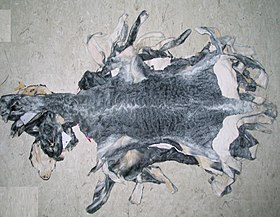Persians
Persians , for some time now often in the trade as Karakul , is the name given to the fur of the Karakul sheep that is a few hours to a few days old .
Skins from prematurely born Karakullammers are called broadtail or Persian broadtail . An initiation of these premature births through external influences on the mother animals is sometimes assumed, for example in Turkmenistan .
The majority of the pelts are obtained in Russia (country of origin of the Karakul breed, trade name of the skins also Bukhara ® ), Afghanistan , Namibia (trade name also Swakara ® ) and South Africa . The term Persian does not denote the country of origin, it is derived from the earlier trade route via Persia .
Skins
According to the RAL designation regulations, Karakul lambskins may be referred to in the trade as "Persians"
if the skins are off
originate with or without a designation of origin (RAL 075 A 2).
| black | Gray | other | |
| Namibia | 75% | 20% | 5% |
| Afghanistan | 27% | 70% | 3% |
| Soviet Union | 70% | 15% | 15% |
The skins of the Russian and Afghan Persian lambs are usually curled with a very beautiful pattern. As a result of breeding, Swakara usually no longer have curls, but rather close-fitting, wavy (moirated) hair, similar to those born prematurely. The old trade name for the skins from Namibia, which is still occasionally used today, was therefore broad-tailed Persian.
The durability coefficient for Persians compared to other types of fur is 60–70%, for broadtail 30–40%.
There is also a naturally brown breed in Afghanistan, the Sur-Persians . The wool is particularly durable and is used for particularly stressed, valuable carpets. The special durability also applies to the Sur Persianer skins. As with all animals, there are also white-haired animals, which are systematically bred, especially in Namibia.
annotation
- ↑ The specified comparative values ( coefficients ) are the result of comparative tests by furriers and tobacco shops with regard to the degree of apparent wear and tear. The numbers are ambiguous; in addition to the subjective observations of durability in practice, there are also influences from fur trimming and finishing as well as numerous other factors in each individual case . More precise information could only be determined on a scientific basis. The division was made in steps of 10 percent each. The most durable types of fur according to practical experience were set to 100 percent.
See also
- Karakul sheep
- Persian fur as a commodity → Karakulfell
- Domestic sheep
- Other types of fur
- fur
- Furrier
literature
- Hans Eberhard Matter / Paul Schöps / Richard M. Franke: Breitschwanz-Karakul: Legend and Reality , Archive for Pelzkunde, Vol. 4, Rifra-Verlag, 1973.
Web links
swell
- ↑ Carol Kerven, Angus JF Russel, Jerry P. Laker ILRI (aka ILCA and ILRAD): Potential for Increasing Producers' Income from Wool, Fiber and Pelts in Central Asia. 2002, 32 pages
- ^ Christian Franke / Johanna Kroll: Jury Fränkel's Rauchwaren-Handbuch 1988/89 , 10th revised and supplemented new edition, Rifra-Verlag Murrhardt, p. 328
- ↑ Dr. Paul Schöps; Dr. H. Brauckhoff, Stuttgart; K. Häse, Leipzig, Richard König , Frankfurt / Main; W. Straube-Daiber, Stuttgart: The durability coefficients of fur skins. In: Das Pelzgewerbe , Volume XV, New Series, 1964, No. 2, Hermelin Verlag Dr. Paul Schöps, Berlin, Frankfurt / Main, Leipzig, Vienna, pp. 56–58




